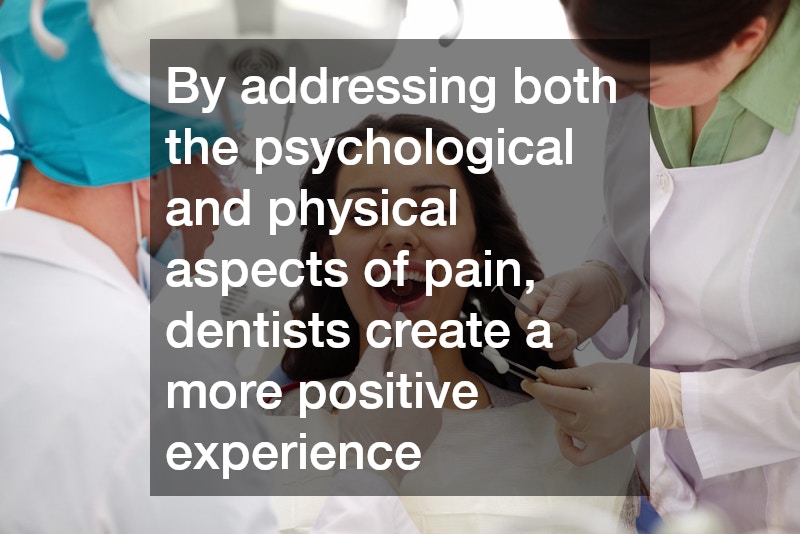
Key Takeaways:
-
Pain-free dentistry combines advanced technology, gentle techniques, and patient-centered care.
-
Highly rated dentists use modern anesthesia and sedation to minimize discomfort.
-
Minimally invasive procedures like laser dentistry and air abrasion reduce pain and recovery time.
-
Managing dental anxiety through communication, relaxation, and sedation improves patient experience.
-
Preventive care and education help avoid invasive treatments and long-term discomfort.
-
Post-procedure guidance and follow-up ensure ongoing comfort and recovery.
-
Choosing a dentist with good reviews ensures a skilled, compassionate, and patient-focused experience.

Visiting the dentist can be a nerve-wracking experience for many people. From the fear of needles to worries about discomfort during procedures, anxiety often keeps patients from seeking the dental care they need. However, a growing number of dentists are revolutionizing the patient experience by focusing on pain-free dentistry. A dentist with good reviews often stands out not only for their technical skills but also for their ability to make patients feel comfortable, relaxed, and well-informed.
In this article, we explore the techniques used by highly rated dentists to minimize discomfort, manage anxiety, and provide a positive dental experience. Whether you are seeking a routine cleaning or a more complex procedure, understanding these strategies can help you feel more confident about your next visit.
Understanding Pain-Free Dentistry
Pain-free dentistry is more than just a marketing term. It encompasses a comprehensive approach to reducing physical discomfort, emotional stress, and anxiety associated with dental treatments. Highly rated dentists recognize that patients’ perceptions of pain are influenced by a combination of physiological and psychological factors.
A dentist with positive reviews typically focuses on:
-
Patient Education: Explaining procedures in simple terms helps patients feel prepared and reduces fear.
-
Advanced Technology: Using modern tools and techniques that minimize invasive procedures.
-
Comfort Measures: Incorporating numbing agents, sedation, or gentle techniques to reduce discomfort.
-
Empathy and Communication: Listening to patients’ concerns and responding with patience and care.
Pain-free dentistry isn’t just about avoiding pain; it’s about creating an experience where patients feel safe, respected, and cared for throughout every step of their visit.
1. Modern Anesthesia and Numbing Techniques
One of the key elements of pain-free dentistry is effective anesthesia. Highly rated dentists understand that traditional numbing methods are not always sufficient for every patient or procedure.
Common techniques used by highly rated dentists include:
-
Topical Anesthetics: Applied to the gums before injections to reduce needle discomfort.
-
Local Anesthesia: Standard injections used to numb specific areas of the mouth. Advanced techniques include using ultra-fine needles for less pain.
-
Computer-Controlled Anesthetic Delivery Systems: These devices slowly administer anesthesia at a controlled rate, reducing the sensation of injection.
-
Sedation Dentistry: Options include:
-
Nitrous Oxide (Laughing Gas): Helps patients relax during procedures.
-
Oral Sedation: Taken as a pill before treatment to induce calmness.
-
IV Sedation: Administered intravenously, offering deeper relaxation while maintaining consciousness.
-
Dentists who consistently receive good reviews are skilled at tailoring anesthesia methods to the patient’s needs, ensuring maximum comfort without compromising safety.
2. Minimally Invasive Techniques
Minimally invasive dentistry is another hallmark of reputable dentists. These techniques reduce discomfort, recovery time, and anxiety, making procedures less intimidating.
Examples of minimally invasive techniques include:
-
Laser Dentistry: Used for gum reshaping, cavity removal, and teeth whitening with minimal discomfort and faster healing.
-
Air Abrasion: A gentle alternative to traditional drilling for treating small cavities, which eliminates vibration and noise.
-
Microdentistry: Focusing on precise treatment to remove only diseased tissue while preserving healthy tooth structure.
-
Digital Impressions: Using scanning technology instead of traditional molds reduces discomfort and gag reflexes.
Patients often report higher satisfaction with these approaches, and dentists who incorporate them frequently receive positive feedback and excellent reviews.
3. Managing Dental Anxiety

Fear and anxiety are significant barriers to regular dental care. Dentists with positive reviews often excel at helping patients manage these emotions through multiple strategies:
Techniques for anxiety management include:
-
Pre-Visit Consultations: Discussing procedures in detail before treatment can ease uncertainty.
-
Relaxation Techniques: Breathing exercises, calming music, or guided imagery during treatment.
-
Patient-Control Options: Allowing patients to signal when they need a break during procedures.
-
Therapeutic Sedation: Using mild sedation to alleviate fear while maintaining responsiveness.
By addressing both the psychological and physical aspects of pain, dentists create a more positive experience that encourages patients to maintain regular care.
4. Advanced Technology for Comfort
Technology plays a pivotal role in the pain-free dental experiences provided by top-rated dentists. Modern tools not only enhance precision but also reduce discomfort and shorten recovery times.
Examples of technology that improve comfort include:
-
Digital X-Rays: Reduced radiation exposure and faster image capture compared to traditional X-rays.
-
Intraoral Cameras: Allow patients to see detailed images of their teeth and gums, increasing transparency and reducing anxiety.
-
Piezoelectric Ultrasonic Scalers: Provide gentle, efficient cleaning with minimal discomfort during dental hygiene appointments.
-
CAD/CAM Technology: Enables same-day crowns and restorations, reducing the number of visits and potential discomfort.
Investing in cutting-edge tools demonstrates a commitment to patient comfort and often correlates with positive patient reviews.
5. Gentle Technique and Skillful Hands
While technology is important, the dentist’s skill and approach are equally crucial. Dentists with good reviews are often praised for their gentle hands, careful technique, and attention to detail.
Key practices include:
-
Slow and Steady Movements: Reduces tissue trauma and discomfort during procedures.
-
Precise Force Application: Ensures that instruments are applied only as needed, avoiding unnecessary pressure.
-
Continuous Patient Feedback: Asking patients about comfort levels throughout procedures.
-
Post-Treatment Guidance: Providing clear instructions to minimize pain and speed up recovery.
Patients often highlight these qualities in reviews, noting that the dentist’s approach made a significant difference in their overall experience.
6. Holistic and Preventive Approach
Top-rated dentists also prioritize prevention and holistic care, which can significantly reduce the need for invasive treatments that cause pain.
Preventive strategies include:
-
Regular Cleanings and Checkups: Early detection of issues minimizes the need for extensive procedures.
-
Patient Education: Teaching proper brushing, flossing, and oral hygiene habits to prevent cavities and gum disease.
-
Dietary Guidance: Recommending foods that support oral health and reduce decay.
-
Fluoride and Sealants: Applying protective treatments that prevent pain-inducing dental problems.
By focusing on prevention, dentists reduce both the physical discomfort of treatments and the emotional stress associated with dental visits.
7. Post-Procedure Comfort and Care
Pain-free dentistry extends beyond the treatment chair. Highly rated dentists ensure patients are comfortable even after leaving the office.
Post-procedure strategies include:
-
Pain Management: Prescribing appropriate medications or recommending over-the-counter options.
-
Follow-Up Calls or Messages: Checking on patient recovery and addressing any concerns.
-
Clear Recovery Instructions: Providing detailed guidance for eating, drinking, and oral hygiene.
-
Emergency Access: Ensuring patients know how to contact the office in case of unexpected discomfort.
These practices demonstrate a dentist’s commitment to comprehensive care, which often earns praise in reviews and strengthens patient trust.
Choosing a Dentist with Good Reviews
When searching for a dentist, online reviews can be a helpful starting point. Dentists with consistently positive reviews often reflect a combination of technical skill, patient-centered care, and attention to comfort.
Tips for finding the right dentist:
-
Read Multiple Reviews: Look for patterns in patient feedback rather than isolated comments.
-
Check for Expertise in Pain-Free Techniques: Look for mentions of sedation, laser treatments, or gentle procedures.
-
Ask Questions: During a consultation, inquire about strategies for minimizing discomfort.
-
Evaluate Communication Style: Choose a dentist who listens and addresses your concerns thoroughly.
-
Consider Office Environment: A welcoming, calm atmosphere is often cited in reviews as a sign of a patient-focused practice.
Choosing a dentist with good reviews ensures you benefit from experience, skill, and an approach centered on comfort and care.
In Closing
Pain-free dentistry is no longer a dream—it is an achievable standard when dentists combine advanced technology, gentle techniques, and thoughtful patient care. Dentists with good reviews consistently demonstrate their ability to reduce discomfort, manage anxiety, and create a positive dental experience.
From modern anesthesia and minimally invasive techniques to attentive communication and post-procedure care, every step is designed to prioritize patient comfort. By seeking out dentists with proven track records, you can enjoy a stress-free visit and maintain your oral health with confidence.
Investing time in finding a dentist with good reviews isn’t just about avoiding pain—it’s about ensuring a long-term partnership that keeps your smile healthy, bright, and comfortable for years to come.